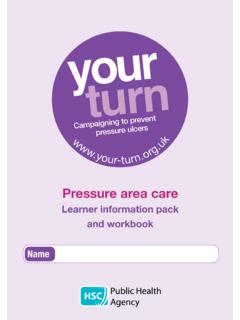Transcription of The Pelvic Floor Muscles - a Guide for Women
1 The Pelvic Floor Muscles - a Guide for WomenThis booklet is supported by Wellbeing of WomenRegistered Charity No. to a third of all Women experience a problem with their Pelvic Floor Muscles at some time during their life. The most common problems are leaking with activity, sneezing or coughing (stress urinary incontinence ) and Pelvic organ prolapse (a feeling of something coming down in the vagina). All the bladder, bowel and sexual functions require good Pelvic Floor Muscles . Effective Pelvic Floor Muscles in pregnancy will reduce the risk of postnatal stress urinary incontinence (SUI).The Pelvic Floor Muscles lie across the base of your pelvis to help keep the Pelvic organs - bladder, uterus and bowel - in the correct position.
2 The Muscles are held in place by ligaments that support the organs especially when there is an increase of pressure in the abdomen that occurs with lifting, bending, carrying and straining. This is called intra-abdominal pressure and when it increases the Pelvic Floor and abdominal Muscles brace so that the internal organs such as the uterus and bladder are not pushed Pelvic Floor Muscles work to help keep the bladder and bowel openings closed to prevent unwanted leakage ( incontinence ) and they relax to 1 BowelUterusBladderPubic BoneTailbonePelvic Floor musclesVaginaUrethraallow easy bladder and bowel emptying. Good Pelvic Floor Muscles can help with sex by improving the vaginal sensation and your ability to Pelvic Floor Muscles are important in posture and with the abdominal Muscles help to support your spine.
3 Not all Women with symptoms have weak Pelvic Floor Muscles , but sometimes they need to learn to use their Pelvic Floor Muscles in the right way and at the right time. Pelvic Floor Muscles should be kept strong and active just like any other muscle in your body. Why do problems occur with the Pelvic Floor Muscles ?CausesThe Pelvic Floor Muscles can be weak, overstretched, slow to work, too tight or torn just like the other Muscles of your body. Pregnancy and childbirth can cause problems for the Pelvic Floor Muscles especially if you have had an assisted vaginal birth, an episiotomy or significant tear or a very large baby. It is important to do your Pelvic Floor exercises regularly during Constipation - having to strain to empty your bowels on a regular basis can cause overstretching and weakness.
4 Difficulties with emptying may be due to poor relaxation of the Pelvic Floor Muscles . Heavy or repeated lifting - causes increases in abdominal pressure which may put your Pelvic Floor Muscles under impact exercise - heavy weights-based and very vigorous gym activities with jumping can overload your Pelvic Floor Muscles . 2 Being very overweight - may increase the pressure on the Pelvic Floor - might cause a regular cough which may put pressure on the Pelvic Floor Muscles . Menopause - vaginal changes after the menopause may make your Pelvic Floor problems conditions which affect the Muscles may have an effect on the Pelvic Floor Muscles neurological conditions and may have more than one of the following symptoms:Bladder: leakage with coughing, sneezing and activity which may include sexual intercourse (stress urinary incontinence ) urgency - a sudden need to go to the toilet that may include leakage (urge urinary incontinence ) going to the toilet too often (frequency) getting up at night to go to the toilet (nocturia)Bowel.
5 Leakage with activity or urge (anal incontinence ) difficulty getting clean after bowel movements leakage of windVaginal: a feeling of something coming down, or heaviness ( Pelvic organ prolapse) pain which can be vaginal or sometimes abdominal lack of sensation during sex34 Finding your Pelvic Floor Muscles It is important to get the right Muscles working in the right way. In a comfortable lying or sitting position imagine that you are trying to stop yourself from passing wind and urine at the same time; drawing the Pelvic Floor Muscles upwards and forwards from the back passage towards the bladder. You may feel a lifting up and tightening as your Muscles contract.
6 Try not to hold your breath; breathe in through your nose, drawing air to the bottom of your lungs and letting your tummy relax, then breathe out through your mouth. You could also try counting out loud to encourage normal tummy may tighten, which is normal, but keep your buttocks and legs relaxed. Let your Pelvic Floor Muscles relax fully after every contraction. There are 3 main ways to check if you are contracting your Pelvic Floor Muscles correctly: 1. using a mirror, the area between your vagina and back passage (perineum) should move up and inwards away from the mirror when you contract your Pelvic Floor Muscles . If you see any bulging - STOP, you may make your Pelvic Floor muscle problem worse.
7 You should try to get help from a specialist physiotherapist (p8) Pelvic Floor muscles2. feel inside your vagina with your thumb or index finger. Tighten your Pelvic Floor Muscles . You should feel the Muscles tightening around your thumb or finger 3. if you are sexually active, you could try to squeeze your Muscles during sex. Ask if your partner can feel the squeeze If you experience pain when exercising the Pelvic Floor Muscles , or if you have abdominal or Pelvic pain after doing the exercises, you should seek specialist advice from a physiotherapist experienced in treating Women with Pelvic Floor problems (see p8).Improving your Pelvic Floor Muscles Pelvic Floor muscle exercises (sometimes called Kegels) should include long, held squeezes as well as short, quick squeezes.
8 You should work the Muscles until they tire and do the exercises regularly to help the Muscles become stronger and more squeezes Tighten your Pelvic Floor Muscles , hold them tight, then release and let them fully relax. How long can you hold the squeeze? Repeat the squeeze and hold until the Pelvic Floor Muscles tire. How many times can you repeat the squeezes?Short squeezes Quickly tighten your Pelvic Floor Muscles , then immediately let them go again. How many times can you do this quick squeeze before the Muscles get tired? Always let the Muscles fully relax after each squeezeAim to be able to do 10 long squeezes, holding each squeeze for 10 seconds, followed by 10 short squeezes.
9 5 You may need to start with little and often if you find that you can only hold the squeeze for a short time, or only do a few before the Muscles tire. You should do your Pelvic Floor muscle exercises at least 3 times each day. You may find it easier to start your programme when you are sitting or lying up your exercise routine gradually over the weeks and months. You should notice an improvement in 3 - 5 months and then keep practising your Pelvic muscle exercises once a day to maintain the improvement. As your Muscles improve, aim to do your exercises in other positions such as standing up. Eventually you can practise these exercises whilst doing activities such as walking and bending.
10 Remembering to exerciseIt is easy to forget to do your Pelvic Floor muscle exercises, particularly when your symptoms start to improve. Try to make them part of a daily routine, doing them at the same time as another activity you already do regularly brushing your teeth. Try the following suggestions: put a reminder on your phone try one of the Pelvic Floor exerciser apps available after emptying your bladder, whilst sitting on the toilet (but don t practise by stopping your urine flow) take a moment to do them when you go to the gym during a regular journey in the car, bus or trainIdeally you will be able to improve your Pelvic Floor Muscles with these exercises.












